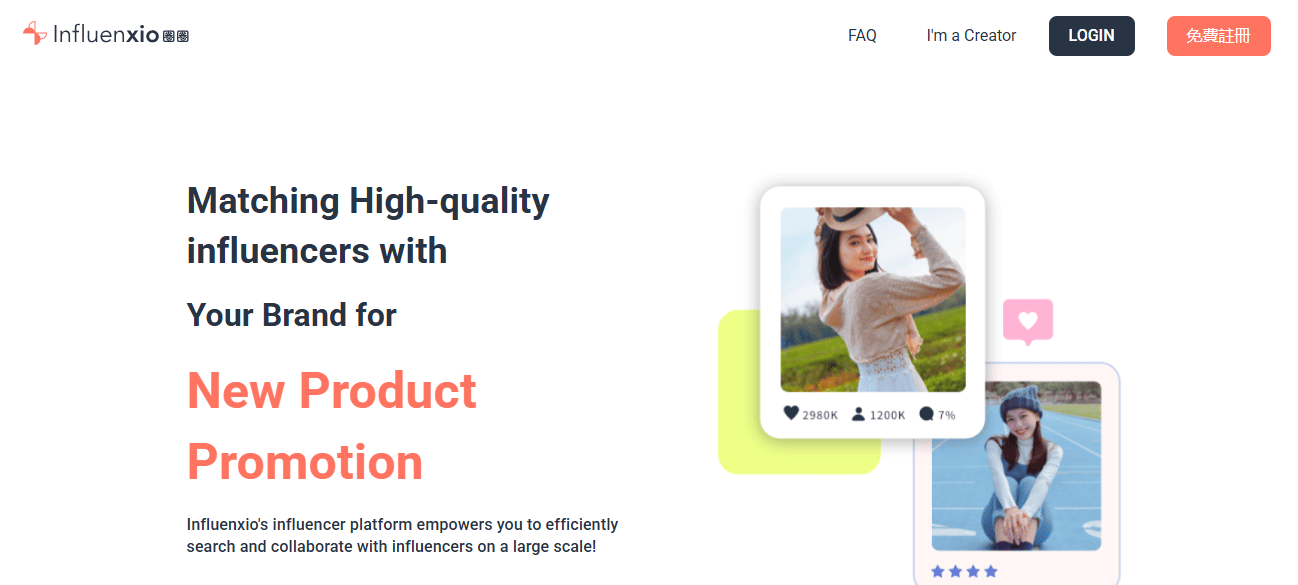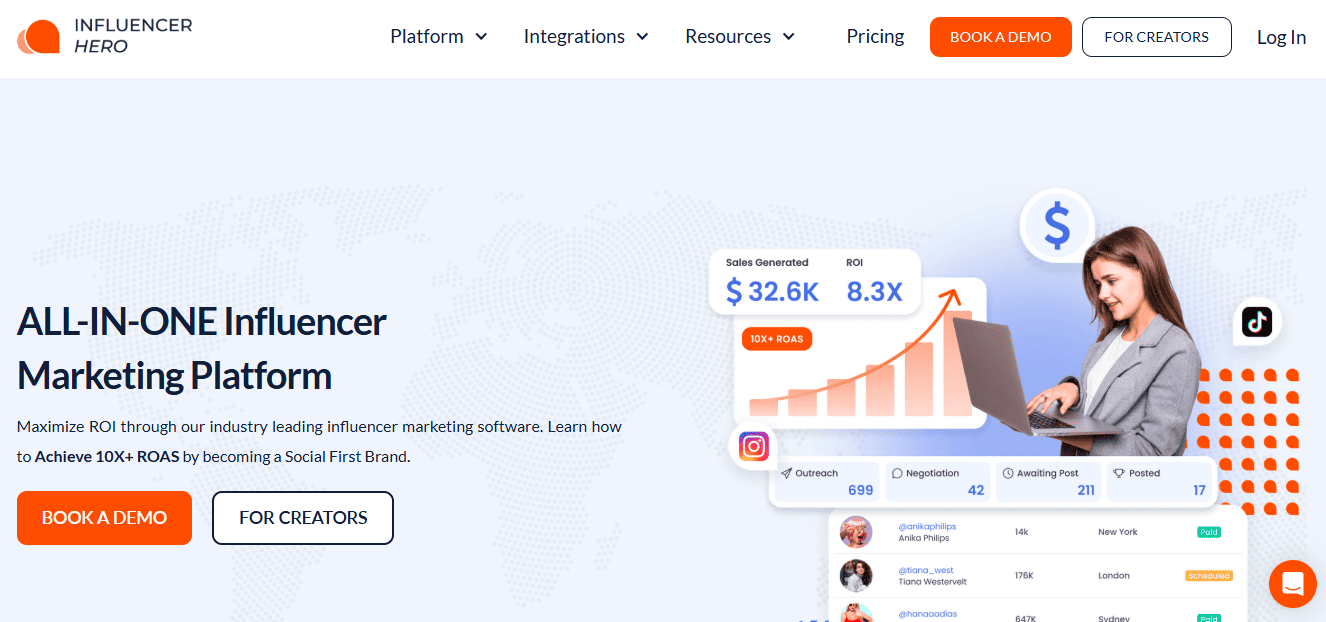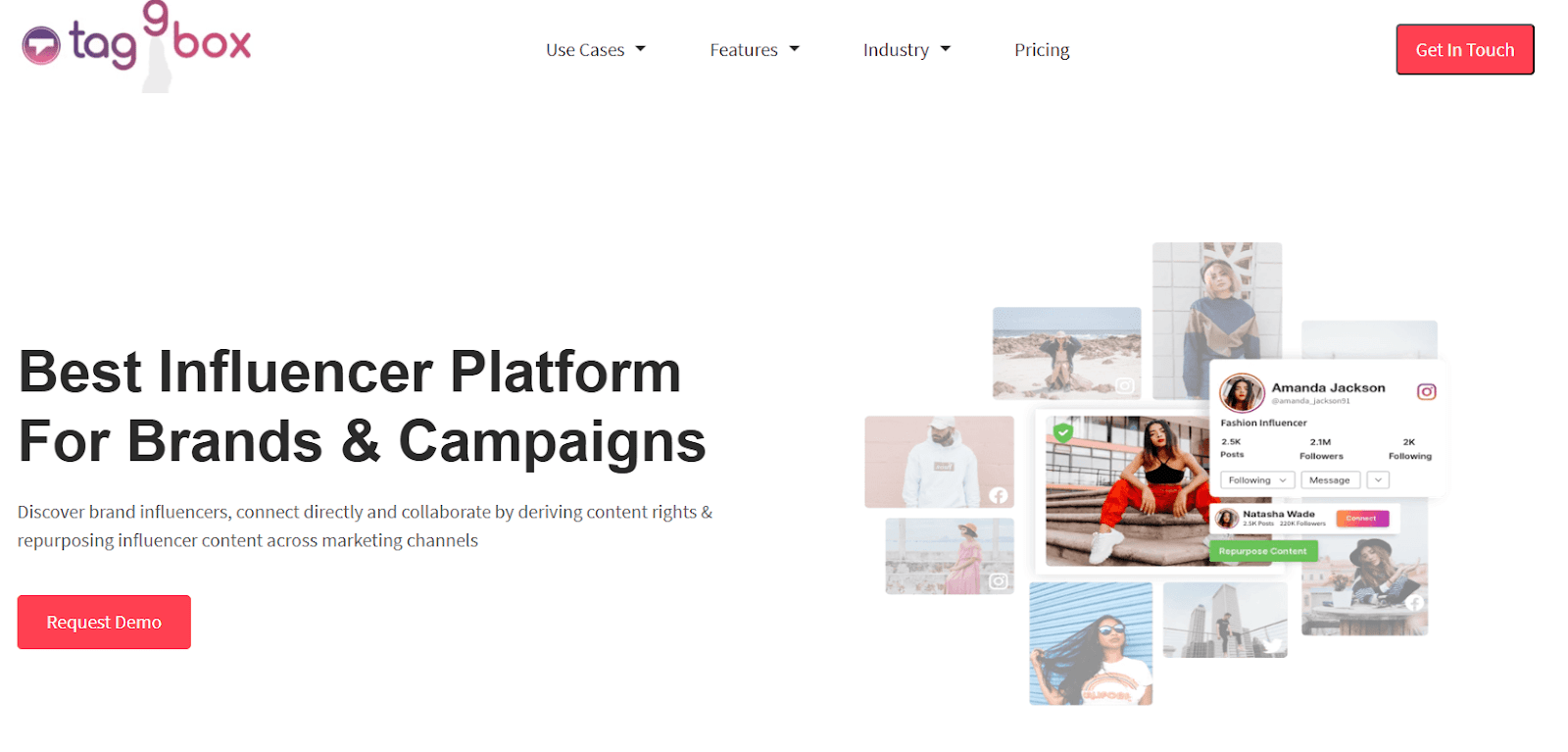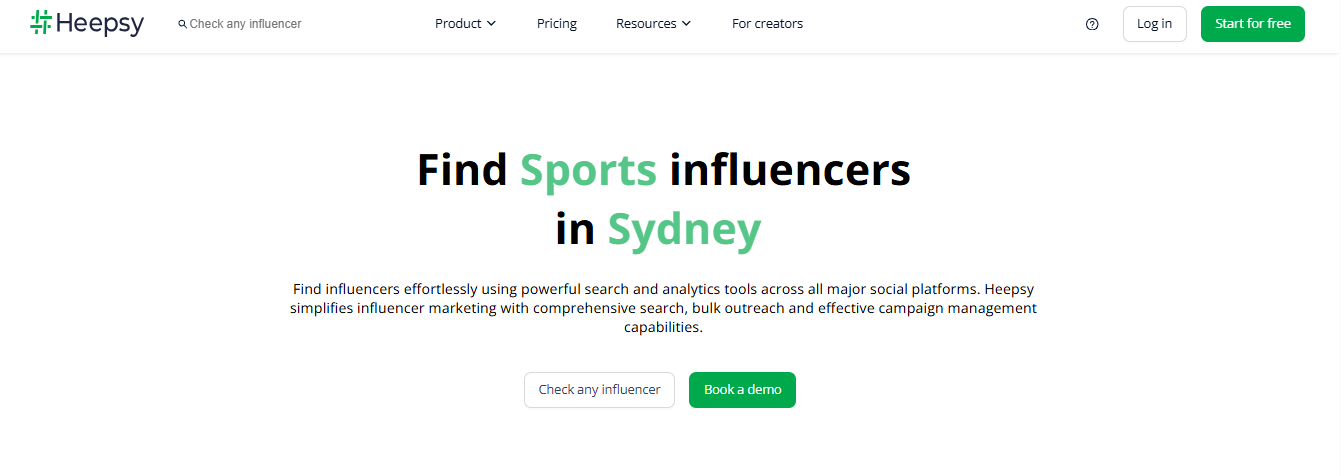


Influenxio, a platform primarily focused on the Asian market, has garnered attention for its influencer marketing capabilities. However, users have highlighted several limitations that have prompted them to seek alternatives. Common concerns include a limited creator base outside Asia, lack of advanced analytics and reporting tools, challenges with payment processing, and a user interface that some find unintuitive.
For brands looking for a superior alternative, Influencer Hero stands out as a top choice, offering a global creator network, advanced analytics, and seamless campaign management. Its intuitive interface and flexible pricing make it an ideal solution for brands seeking efficiency and measurable results.
In this article, we will explore the top 10 alternatives to Influenxio, providing insights into their features, pricing, and user reviews:
Each of these platforms brings unique strengths to the table, catering to various aspects of influencer marketing. Whether you're looking for comprehensive campaign management, advanced analytics, or a user-friendly interface, this guide will help you identify the best fit for your brand's needs.
Before deciding to use Influenxio, it’s important to consider some of the challenges users have experienced. Based on our research, here are four specific reasons why some users look for alternatives:
Many users have noted that Influenxio's primary focus is on Asian markets, leading to a limited selection of influencers in regions like North America and Europe. This geographic concentration can be a significant drawback for brands aiming for global campaigns.
Feedback from users indicates that Influenxio's analytics dashboard lacks depth, making it challenging for brands to assess campaign performance effectively. The absence of advanced reporting features can hinder data-driven decision-making.
Some influencers have reported issues with payment delays and limited payout options on Influenxio. These challenges can create friction in the creator-brand relationship and may deter potential collaborators.
Several users have expressed concerns about the platform's user interface, describing it as unintuitive and difficult to navigate. A cumbersome user experience can lead to inefficiencies and frustration for both brands and influencers.
Our comparison focuses on several key aspects:

Best For: Influenxio is best suited for small to medium-sized businesses that want to run cost-effective, Instagram-focused campaigns with micro-influencers. It’s particularly valuable for brands in Asia or those seeking to enter APAC markets with quick, budget-friendly influencer activations.
Platform Coverage:
Pricing: Based on our research, Influenxio offers flexible plans with both free and paid options.
Reviews: No verified public reviews available on major platforms such as G2, Capterra, or Trustpilot.
Ease of Use (UX/UI): Influenxio’s interface is designed with simplicity and accessibility in mind, making it approachable even for teams without dedicated marketing staff. The “review-first, post-later” workflow ensures brands can approve influencer content before publication, reducing risk.
Customer Support: Influenxio combines a self-service model with additional support for SMBs, including automated creator matching and campaign analytics. Support is available via online channels and onboarding documentation. However, external feedback is somewhat limited, and some reviewers have flagged concerns around payment processing delays and UI guidance, suggesting that while the support is responsive, it may lack the depth of larger enterprise platforms.

Best For: D2C and eCommerce brands (Shopify, WooCommerce, custom carts) that want an all-in-one influencer stack to scale discovery, outreach, seeding, affiliates, and reporting with automation—especially teams focused on ROI and operating across multiple social platforms.
Platform Coverage:
Pricing: Influencer Hero offers flexible pricing plans to accommodate growing brands. All plans include core features and can scale as the influencer program grows.
Reviews: 5.0 / 5.0 (Capterra)
Ease of Use (UX/UI): Known for an intuitive, clean interface with a streamlined dashboard. Automated workflows and customizable email templates help teams move fast, and the Chrome extension saves hours each week.
Customer Support: 24/7 real-human live chat, responsive email support, and an extensive Help Center with written and video tutorials. Every plan includes a dedicated account manager from day one, with optional strategy consultations. Pro plan users also get a private Slack channel for faster, continuous support.
Influenxio is a budget-friendly, Instagram-focused tool with a free tier and a paid Advanced Flexible Plan around NT$4,990/mo (~US$155), plus matching-fee and self-quote models—great for quick, simple IG campaigns for SMBs. But coverage is Instagram-only, public reviews are scarce, and the broader analytics/operations depth is limited.
Influencer Hero costs more upfront (starting at $649/mo), but you get an enterprise-grade, 8-platform solution that unifies discovery, AI outreach, CRM, gifting, content capture, affiliates, and ROI reporting—backed by premium onboarding and a 5.0/5.0 user rating.
If you need multi-network scale, reliable reporting, and automation to run high-volume programs, Influencer Hero delivers far more capability per dollar as you grow.

Best For: DTC brands—especially Shopify stores—and lean agencies that want an end-to-end engine for discovery, outreach, CRM, real-time tracking, affiliate payouts, and Shopify-powered gifting across Instagram, TikTok, and YouTube.
Platform Coverage:
Pricing: There are different plans and options.
Reviews: 4.7/5 (G2)
Ease of Use (UX/UI): Teams highlight powerful filters and AI visual/text discovery for fast shortlists, then move creators through CRM statuses with Gmail/Outlook sync. Shopify gifting (self-serve product selection, auto codes/UTMs, tagged orders) centralizes attribution in the same dashboard, with fake-follower checks and real-time analytics to judge quality quickly.
Customer Support: Materials call out excellent onboarding and support, plus clear usage guardrails (e.g., views, email unlocks, tracked creators, seats) on published plans—useful for planning scale.
Influenxio is an Instagram-only marketplace-style platform with self-quote pricing, an AI matching/invite system, and a review-first workflow so content is approved before posting—built for quick, simple SMB campaigns. It also offers a “Drive Website Traffic and Conversion” mode where creators apply for affiliate links and brands are charged based on clicks, with performance data to assess results. Modash is a full platform for IG/TikTok/YouTube with AI discovery, CRM + outreach, real-time tracking, Shopify gifting/affiliate, and automated payouts—better for ongoing programs and revenue attribution.
Influenxio has a free plan and an Advanced plan at NT$4,990/month (≈US$155) or NT$49,900/year (≈US$1,550), plus a one-time NT$1,000 matching fee that applies as budget credit; influencers then set their own rates per collaboration. Modash publishes annual pricing—Essentials US$199/month and Performance US$499/month—with usage limits suitable for active teams. Your choice is essentially Instagram-only, pay-per-creator/click economics versus an always-on, Shopify-centric platform license.
Pick Influenxio if you need fast, budget-sensitive Instagram campaigns with content pre-approval and flexible per-creator pricing. Choose Modash if you want a repeatable engine to scale discovery, outreach, CRM, tracking, affiliate payouts, and Shopify gifting across the big three, with stronger quality controls and attribution for DTC revenue teams.

Best For: Mid-market and enterprise eCommerce brands—especially Shopify and Amazon sellers—who want an end-to-end influencer stack with native sales attribution.
Platform Coverage:
Pricing:
Reviews: 4.5/5 (G2)
Ease of Use (UX/UI): Users highlight that Upfluence consolidates searching, outreach, tracking, and payments into one place, reducing tool-switching. That power comes with a learning curve for new teams, particularly during initial setup and workflow tuning.
Customer Support: The materials emphasize implementation around Shopify/Amazon tracking and payouts rather than detailed support SLAs. Feedback in the deck focuses more on capabilities and the engagement model (e.g., annual commitments, no free trial) than on day-to-day responsiveness.
Influenxio is Instagram-only and optimized for SMBs with a low entry cost—its Advanced Flexible Plan is about NT$4,990/month (~US$155) or NT$49,900/year (~US$1,547), and there’s also a free tier. That budget profile and emphasis on quick, simple campaign execution make it attractive for small teams testing influencer marketing without heavy commitments. However, public ratings are scarce, and advanced analytics and multi-network coverage are limited.
Upfluence, by contrast, is a multi-platform, end-to-end solution with deep eCommerce ties (Shopify/Amazon) and robust tracking, outreach automations, and payouts—priced from $1,276/month on annual terms with no commission fees. It’s the stronger choice when you need multi-network scale, revenue attribution, and integrated payments; Influenxio is the better fit when you need a low-cost, Instagram-centric tool to spin up basic campaigns.

Best For: Mid-market and enterprise brands that want an end-to-end suite for discovery, collaboration, tracking, and reporting across multiple networks, with options to layer Storefronts and Affiliate for creator commerce at the high end.
Platform Coverage:
Pricing: There are different pricing options:
Reviews: 4.1/5 (G2)
Ease of Use (UX/UI): Users appreciate having search, campaign management, and analytics in one place. Team workflows are streamlined with multi-collaborator approvals, creator and teammate chat, and saved “filter locks” so you can reuse complex searches without rebuilding them. Drag-and-drop metrics and shareable report links reduce recurring report work.
Customer Support: Materials position Captiv8 for larger programs with annual onboarding and enterprise implementations. Public chatter flags support responsiveness and payout issues for some users, so brands typically clarify SLAs and finance flows during procurement.
Influenxio is an Instagram-only platform built for quick SMB activations: creators self-quote, brands can require review-first content approval, and there’s a click-based affiliate mode where you set a budget and pay on actual website traffic. Captiv8 is a full enterprise stack spanning discovery, campaign collaboration, and deep analytics, plus optional Storefronts and Affiliate for large-scale creator commerce.
Influenxio offers a Free plan and an Advanced plan at NT$4,990/month (~US$155) or NT$49,900/year, with a NT$1,000 matching fee that converts to campaign credit. Captiv8 requires $25,000/year plus $3,000 onboarding, and $20–30k/month for Storefronts + Affiliate, positioning it for teams with enterprise budgets and goals.
Choose Influenxio if you need fast, budget-sensitive Instagram campaigns with pre-approval workflows and flexible per-creator pricing. Choose Captiv8 if you want multi-network discovery, collaborative campaign ops, and robust analytics with the option to add commerce storefronts—best for brands running always-on, data-driven programs at scale.

Best For: Mid-market to enterprise brands that need a compliant, end-to-end influencer OS—discovery, activation, CRM, reporting, and finance—tied to real-time APIs and executive-ready analytics. Strong fit for teams that want robust governance, payments at scale, and strategic onboarding.
Platform Coverage:
Pricing: There are different plans:
Reviews: 4.7/5 (G2)
Ease of Use (UX/UI): The demo emphasizes a lifecycle-based UX—search → approvals (one-sheets) → briefs → tracking—plus customizable dashboards with live, no-login share links for stakeholders. The breadth of controls is powerful, though new teams should expect some setup and onboarding to unlock its full potential.
Customer Support: CreatorIQ pairs each account with an implementation manager and a customer success team for onboarding, quarterly planning, and strategic guidance. Deep social-platform partnerships (Meta, TikTok, YouTube) also translate to early feature access and reliable, compliant data flows.
Influenxio vs CreatorIQ
Influenxio is Instagram-only and cost-effective—there’s a free plan and an Advanced Flexible Plan at NT$4,990/month (~US$155) or NT$49,900/year (~US$1,547). Its strengths are simplicity, fast launches, and budget flexibility for SMBs, but public ratings are scarce and analytics are comparatively light.
CreatorIQ is a multi-platform, enterprise-grade suite with API-level data, custom live reports, approvals, CRM, and built-in payments (0% processing up to $100K/year, then 2%). It’s sold on annual contracts and typically scoped around $2K–$5K/month, making it the better choice when you need governance, reliable measurement, and scaled operations across several networks.
Choose Influenxio for low-cost, Instagram-centric campaigns; choose CreatorIQ for sophisticated, cross-platform programs with executive-level reporting and finance workflows.

Best For: Brands and agencies that need fraud-safe discovery and measurement across Instagram, TikTok, YouTube, Twitch, X, and Snapchat, with built-in outreach, contracts, content approvals, ecommerce attribution, and shareable reporting.
Platform Coverage:
Pricing: HypeAuditor’s pricing is customizable, with the standard “Business” plan starting at around $10,000/year. Pricing can be adjusted based on the number of reports, active campaigns, and platform usage. They also offer a 24–48 hour free trial for new users.
Reviews: 4.6/5 (G2)
Ease of Use (UX/UI): Users highlight powerful filters, AI category search, lookalikes, and social listening to build precise shortlists fast. Lists flow into outreach with email, DM, or in-platform messaging and template sequences; reports are shareable via link or PDF. There is a mild learning curve that’s usually covered in onboarding.
Customer Support: HypeAuditor offers a 24–48h free trial and customizable pricing; standard “Business” packages include onboarding and support. Teams often scope usage needs up front—reports, networks, and active campaigns—to fit the custom plan.
Influenxio is Instagram-only, optimized for quick SMB campaigns with AI matching/invites, a review-first workflow where drafts are approved before posting, and a click-based affiliate mode that charges on actual website traffic. HypeAuditor spans IG, TikTok, YouTube, Twitch, X, Snapchat, layering AI discovery, social listening, outreach/CRM, contracts with e-sign, draft approvals, and Shopify ROI tracking with shareable reports—better for teams that need cross-channel verification and robust reporting.
Influenxio offers a Free plan and Advanced plan at NT$4,990/month (≈US$155) or NT$49,900/year (≈US$1,550), plus a NT$1,000 matching fee that applies as campaign credit and creator self-quote pricing. HypeAuditor provides a 24–48h free trial and customizable packages, with a standard Business plan around $10K/year including onboarding and support.
Choose Influenxio if you want low-cost Instagram campaigns with pre-approvals and flexible per-creator pricing; choose HypeAuditor if you need multi-network discovery, fraud checks, and ecommerce attribution with enterprise-style reporting.

Best For: DTC and eCommerce brands that want an end-to-end workflow—discovery, outreach, CRM, gifting, payments, UGC, and ROI analytics—in one place, with deep storefront integrations and unlimited creator capacity.
Platform Coverage:
Pricing:
Reviews: 4.5 / 5.0 (G2)
Ease of Use (UX/UI): Users like having the full campaign workflow in one place—from outreach and gifting to analytics—which reduces tool switching and speeds execution. However, feedback also calls out performance hiccups (slow loads, glitches, occasional crashes) that can interrupt work, and search quality complaints (duplicates or irrelevant results) that require extra vetting.
Customer Support: Brands highlight helpful onboarding options and the availability of program strategists (optional) when needed. That said, some users report uneven follow-through—delays, unresolved tickets, or billing frustrations tied to broken features—so support experiences can vary by account.
Influenxio is Instagram-only and built for SMBs that need a low-cost, self-service option. It offers a Free plan and an Advanced Flexible Plan at NT$4,990/mo (~US$155) or NT$49,900/year (~US$1,547), along with a simple review-first workflow and automated matching. Public ratings are limited, and analytics depth is lighter—so it’s best for quick, budget-conscious tests rather than complex, cross-channel programs.
GRIN, by contrast, is a multi-platform operating system with eCommerce-native gifting, in-app PayPal payouts, CRM, and ROI/affiliate analytics. Pricing typically starts around $2.5K+/month (often cited as $25K/year minimum) with 12-month terms, reflecting its enterprise focus.
Choose Influenxio if you’re cost-sensitive and testing on Instagram; choose GRIN if you need scaled eCommerce workflows, unlimited creators, and unified reporting across platforms.

Best For: Brands and agencies that want to collect, manage, and repurpose UGC across multiple networks, add shoppable social proof to sites, and do light influencer discovery without a full-blown influencer CRM.
Platform Coverage:
Pricing: Taggbox offers four main subscription plans, each with higher feed limits, faster content updates, and expanded moderation tools.
Review: 4.8 / 5.0 (G2)
Ease of Use (UX/UI): Users like the quick setup for multi-network feeds, easy embedding, and a dashboard that helps organize content, moderate, and track performance. Some teams find the backend less intuitive at first and note that certain updates or settings changes can take longer to appear.
Customer Support: Paid plans get responsive chat and call support plus helpful docs and video tutorials; Free plans lean more on self-service resources. Overall feedback is positive, though a few users mention minor technical glitches and a learning curve when navigating advanced options.
Influenxio is Instagram-only and optimized for quick SMB activations with an AI matching/invite system, review-first content approvals, and a click-based affiliate mode that pays for website traffic. Taggbox spans multiple networks and focuses on UGC aggregation, rights management, moderation, and shoppable embeds; it is not a full influencer CRM but excels at turning community content into on-site social proof.
Influenxio has a Free plan and an Advanced plan at NT$4,990/month (~US$155) or NT$49,900/year, plus a NT$1,000 matching fee that converts to budget credit; creators then self-quote their rates. Taggbox offers a Free plan and low-cost paid tiers at $19, $29, and $79/month, scaling feed limits, update speed, and support levels. Your call is Instagram campaigns with per-creator economics versus multi-platform UGC infrastructure for social commerce and brand proof.
Pick Influenxio if you want fast, budget-sensitive Instagram campaigns with pre-approvals and flexible creator pricing. Choose Taggbox if your priority is to collect, rights-clear, and activate UGC across channels with real-time moderation and shoppable widgets—ideal for ecommerce brands and agencies building sustained social proof.

Al text: img src="heepsy-overview-Influenxio-alternatives" alt="Heepsy Overview Influenxio Alternatives
Best For: Lean ecommerce teams and mid-market brands that need fast, high-volume discovery, bulk outreach, simple CRM, and optional Shopify/WooCommerce sales tracking without enterprise lock-ins.
Platform coverage:
Pricing & Commitment: There are different plans:
Reviews: 4.5 / 5 (G2)
Ease of Use (UX/UI): Heepsy’s multi-filter search makes shortlisting straightforward, then lists move into a Kanban-style pipeline so you can track emailed, approved, shipped, sales, and paid at a glance. Bulk outreach with templates and automated follow-ups speeds first contact; most teams are productive after a brief onboarding.
Customer Support: Expect onboarding calls, helpful CS, and flexible terms—monthly, 6-month, and annual—with occasional seasonal discounts. Advanced plan customers get Shopify integration and sales attribution, plus larger outreach limits for scaling affiliate programs.

Top options include Influencer Hero, Modash, Upfluence, GRIN, HypeAuditor, Heepsy, and CreatorIQ. If you want an all-in-one stack without stitching tools, Influencer Hero is a standout. Modash is great for Shopify-centric discovery, outreach, and affiliate tracking. Upfluence and GRIN excel when you need ecommerce attribution and payouts at scale. HypeAuditor focuses on authenticity and fraud checks, while Heepsy offers budget-friendly, self-serve discovery.
If tying creators to revenue is crucial, look at Upfluence and GRIN for deep ecommerce workflows and bulk payments. Modash is strong for Shopify teams that want gifting, codes, links, and affiliate analytics in one place. Influencer Hero is a balanced choice for brands that want discovery, outreach, tracking, and affiliate capabilities in a single platform without enterprise overhead.
Yes. Heepsy offers self-serve plans suited to lean teams that need fast discovery and simple CRM. Modash publishes transparent tiered pricing for growing DTC brands. If you want an all-in-one platform you can grow into, Influencer Hero provides a full lifecycle toolset—discovery, outreach, analytics, and affiliate—without the complexity of enterprise suites.
For multi-network programs across Instagram, TikTok, YouTube, and more, consider Influencer Hero, CreatorIQ, Upfluence, HypeAuditor, and Modash. These tools add broader discovery, cross-channel reporting, and workflows that support ongoing campaigns rather than one-off activations.
Use this checklist:
If you want an end-to-end, revenue-oriented workflow with minimal tool sprawl, Influencer Hero is a strong pick that balances capability, simplicity, and scale.
Schedule a Demo with one of our media experts below.